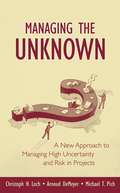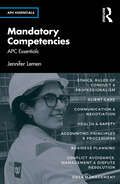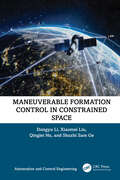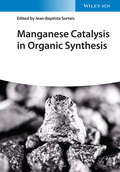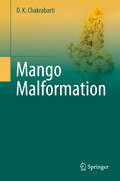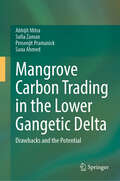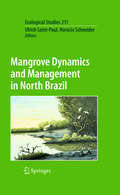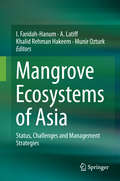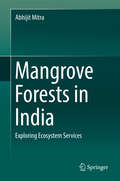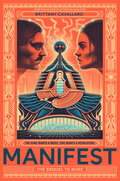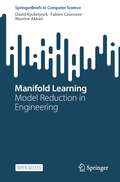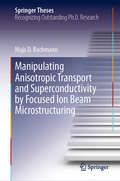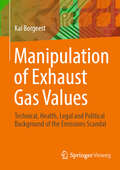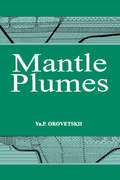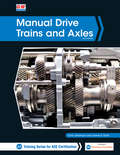- Table View
- List View
Managing the Unknown
by Arnoud Demeyer Christoph H. Loch Michael T. PichManaging the Unknown offers a new way of looking at the problem of managing projects in novel and unknown environments. From Europe's leading business school, this book shows how to manage two fundamental approaches that, in combination, offer the possibility of coping with unforeseen influences that inevitably arise in novel projects:* Trial-and-Error Learning allows for redefining the plan and the project as the project unfolds* Selectionism pursues multiple, independent trials in order to pick the best one at the endManaging the Unknown offers expert guidelines to the specific project mindsets, infrastructures, and management methods required to use these project management approaches and achieve success in spite of unforeseen obstacles. This book equips readers with:* Causal explanations of why unforeseeable factors in novel projects make traditional project planning and project risk management insufficient* Directly applicable management tools that help managers to guide novel and high-uncertainty projects* Real-world case studies of both successful and unsuccessful approaches to managing high uncertainty in novel projects
Mandatory Competencies: APC Essentials (APC Essentials)
by Jen LemenMandatory Competencies: APC Essentials is the first book in a new series designed to cover what any RICS APC (and AssocRICS) candidate or qualified surveyor needs to know about the mandatory competencies.Written by Jennifer Lemen, author of How to Become a Chartered Surveyor and co-founder of one of the UK’s market leading APC training providers, Property Elite, this guide is packed full of bite sized information covering: Ethics, Rules of Conduct and Professionalism Client Care Communication and Negotiation Health and Safety Accounting Principles and Procedures Business Planning Conflict Avoidance, Management and Dispute Resolution Procedures Data Management Diversity, Inclusion and Teamworking Inclusive Environments Sustainability Senior Professional Assessment Mandatory Competencies Submission and Interview Advice Practical and concise, with bullet point checklists and real-life examples and diagrams, this handy guide tells you everything you need to know about the RICS mandatory competencies when studying for your APC or your university exams. Relevant to candidates on all APC pathways, including Commercial Real Estate, Residential, Valuation, Quantity Surveying and Construction, Planning and Development, Building Surveying, Land and Resources, this book will also be a handy reference for qualified surveyors and property professionals. This book will also help you to better support your candidates if you are an APC or AssocRICS Counsellor or Supervisor.
Maneuverable Formation Control in Constrained Space (ISSN)
by Qinglei Hu Dongyu Li Xiaomei Liu Shuzhi GeInspired by the community behaviors of animals and humans, cooperative control has been intensively studied by numerous researchers in recent years. Cooperative control aims to build a network system collectively driven by a global objective function in a distributed or centralized communication network and shows great application potential in a wide domain. From the perspective of cybernetics in network system cooperation, one of the main tasks is to design the formation control scheme for multiple intelligent unmanned systems, facilitating the achievements of hazardous missions – e.g., deep space exploration, cooperative military operation, and collaborative transportation. Various challenges in such real-world applications are driving the proposal of advanced formation control design, which is to be addressed to bring academic achievements into real industrial scenarios. This book extends the performance of formation control beyond classical dynamic or stationary geometric configurations, focusing on formation maneuverability that enables cooperative systems to keep suitable spacial configurations during agile maneuvers. This book embarks on an adventurous journey of maneuverable formation control in constrained space with limited resources, to accomplish the exploration of an unknown environment. The investigation of the real-world challenges, including model uncertainties, measurement inaccuracy, input saturation, output constraints, and spatial collision avoidance, brings the value of this book into the practical industry, rather than being limited to academics.
Manganese Catalysis in Organic Synthesis
by Jean-Baptiste SortaisThis unique book highlights the most important reactions in the presence of homogeneous manganese catalysts, e.g. reduction reactions, C-H functionalization, cross-coupling reactions etc.
Mango Malformation
by D. K. ChakrabartiMalformation disease of mango (Mangifera indica) initially noted in patches in India has now turned into a global menace wherever mango is grown. The challenge posed by the problem attracted interest of Scientists from various disciplines, continue to do so, and will attract their attention until the problem is understood threadbare, and resolved. For a long time, due to complex nature of the disease, the cause and causal agent was both hotly debated. Only in recent years, the issue of the etiology of the disease has been resolved, epidemiology has been worked out to a large extent and silver bullet control measures have been replaced by IPM strategy based on the information generated on the physiology of pathogenesis and epidemiology of the disease.
Mangrove Carbon Trading in the Lower Gangetic Delta: Drawbacks and the Potential
by Abhijit Mitra Sufia Zaman Prosenjit Pramanick Sana AhmedTrue mangrove flora and their associates in the lower Gangetic region are noted for their wide spectrum of ecosystem services in which carbon storage and sequestration by the forest is one of the most important components. Many researchers are updating the carbon repository of the lower Gangetic delta mangroves with the aim to ascertain their role to reduce the carbon dioxide level of the near surface atmosphere. However, due to difficulty in assessment, marketing, and lack of clarity over ownership of natural resources, the mangrove-based carbon trading system has not yet crystallized.There is an estimated 13.76 Mha of mangrove forests world-wide, approximately 20% (2.6 Mha) of which is potentially investible for carbon finance projects, based on the probability of imminent threat. The magnitude and the variability of threats to which the mangroves of the lower Gangetic delta are exposed to have made the trading process more complicated. In addition, gaps also exist between the national government policy and the trading of the blue carbon projects, which has kept the future of such projects remain on hold. The authors put forward the views that the creation of more financial facilities for restoration and expansion of blue carbon (preferably mangroves) with the involvement of the local communities can provide the initial capital involved in developing mangrove-based carbon projects. This includes the costs of conducting feasibility studies, implementing capacity-building programs, monitoring the health of the mangrove plantation/restoration on regular basis, and creating mangrove-based alternative livelihood programs that will support island dwellers of the region in order to accelerate the magnitude of mangrove-based carbon projects leading to growth of the mangrove trading market.
Mangrove Dynamics and Management in North Brazil
by Horacio Schneider Ulrich Saint-PaulMangrove ecosystems are being increasingly threatened by human activities. Their biotic productivity supplies food and other resources to the human populations that inhabit or make use of them. This volume highlights the results of a ten-year German / Brazilian research project, called MADAM, in one of the largest continuous mangrove areas of the world, located in northern Brazil. Based on the analysis of the ecosystem dynamics, management strategies for the conservation and sustainable use of mangroves are presented and discussed. Beyond the scientific results, this book also provides guidelines for the development of international cooperation projects.
Mangrove Ecosystems of Asia
by Khalid Rehman Hakeem Munir Ozturk I. Faridah-Hanum A. LatiffThe book provides an up-to-date account of mangrove forests from Asia, together with restoration techniques, and the management requirements of these ecosystems to ensure their sustainability and conservation. All aspects of mangroves and their conservation are critically re-examined. The book is divided into three sections presenting the distribution and status of mangrove ecosystems in Asia, the challenges they are facing, their issues and opportunities, and the management strategies for their conservation.
Mangrove Forests in India: Exploring Ecosystem Services
by Abhijit MitraThis is the first comprehensive science-based primer to highlight the unique ecosystem services provided by mangrove forests, and discuss how these services preserve the livelihoods of coastal populations. The book presents three decades of real-time data on Sundarbans and Bhitarkanika mangroves in India measuring carbon and nitrogen sequestration, as well as case studies that demonstrate the utility provided by mangroves for reducing the impact of storms and erosion, providing nutrient retention for complex habitats, and housing a vast reservoir of plant, animal and microbial biodiversity. Also addressed is the function of mangroves as natural ecosystems of cultural convergence, offering the resources and products necessary for thriving coastal communities. The book will be of interest to students, academics and researchers in the fields of oceanography, marine biology, botany, climate science, ecology and environmental geography, as well as consultants and policy makers working in coastal zone management and coastal biodiversity conservation.
Mangroves and Aquaculture: A Five Decade Remote Sensing Analysis of Ecuador’s Estuarine Environments (Coastal Research Library #33)
by Stuart E. HamiltonThis book uses five decades of map data, air photos, and medium to high-resolution satellite imagery to track the expansions of aquaculture and the loss of both estuarine and mangrove land covers in Ecuador. The results are staggering. In some regions, Ecuador has lost almost 50% of its estuarine space and approximately 80% of its mangrove forest. The current estuarine land cover bears no resemblance to the historic estuarine land cover. The analysis is complete from 1968 to 2014. The analysis covers all the major estuaries of mainland Ecuador. The research expands beyond purely land cover into the land use of the estuaries and the implications of the land cover transitions. The author lived in Ecuador's estuarine environments for almost two years studying this area. During this time he conducted mapping workshops with local residents, conducted 100 interviews with local actors, conducted six group discussions with fisherfolk syndicates, conducted eight presentations, worked on a shrimp farm. He was employed by the Ministry of the Environment on a Prometeo fellowship for one-year researching estuarine health and worked on mangrove replanting projects in the estuaries. In addition to the remote sensing data, the author provides a contextual framework to the analysis. It is not just hard numbers that are presented, but a remote sensing analysis tied to local actors that tell a coherent almost 50 -year estuarine story at the national, provincial, and local scales The book is intended for researchers, academics, graduate students, NGOs, and government actors including those who work in development, environment, and policy implementation. It is suitable supplemental reading for students in courses related to the coastal zone, land use change, and remote sensing. The electronically supplementary material includes all the related data to underpin the analysis as well as all the resulting GIS files.
Mangroves: Biodiversity, Livelihoods and Conservation
by Sudhir Chandra Das Pullaiah Thammineni Elizabeth C. AshtonThis contributory volume is a comprehensive collection on the mangrove forest eco-system and its ecology, the resources and potentials of mangroves, conservation efforts, mangrove eco-system services and threats to conservation. The book is an all-inclusive compilation on the status, conservation and future of mangroves. Mangroves are a unique ecosystem providing several ecosystem services. They are formed in the inter-tidal areas of large rivers and coastal islands. Mangroves thrives due to constant interaction with the terrestrial and marine ecosystem. These are the species dynamics, varying tidal amplitudes, plant succession, changing floral pattern of the channels of the estuary, the varying sediment transportation. There was 20% decline in mangrove forest area in the last 25 years due mainly to conversion and coastal development. Lengthy recovery periods required for the degraded mangrove forests. Hence there is an urgent need to take stock of the updated information on these mangroves at global level. It is of immense value to scientific community involved in teaching, research and extension activities related to mangrove conservation.
Manifest
by Brittany CavallaroNew York Times bestselling author Brittany Cavallaro delivers the thrilling conclusion to her YA duology set in a reimagined American monarchy about a girl fighting for her own freedom, trying to change the government from within . . . or burn it all down.For the first time in her life, Claire Emerson isn’t under a man’s control. She’s escaped from her dangerous father, and her fiancé, Governor Remy Duchamp, is too weak to rule. All eyes fall on Claire—and the power she could wield.But that power is precarious as she and Remy are leading St. Cloud in exile after the General’s attempted coup. And when King Washington descends on the small province, he brings with him his baseball team, Claire’s brother, and a proximity to power Claire has never dreamed of. With few allies to support her, she determines her best chance at survival is earning the King’s good graces. Claire’s schemes quickly get out of hand, reminding her that it isn’t about who holds the power. It’s about a system that grants such power to a select few, and the men who built it that way. Claire isn’t anyone’s muse, and if she can’t fix the system from within, she’s determined to be the spark of revolution in the First American Kingdom.
Manifold Learning: Model Reduction in Engineering (SpringerBriefs in Computer Science)
by David Ryckelynck Fabien Casenave Nissrine AkkariThis Open Access book reviews recent theoretical and numerical developments in nonlinear model order reduction in continuum mechanics, being addressed to Master and PhD students, as well as to researchers, lecturers and instructors. The aim of the authors is to provide tools for a better understanding and implement reduced order models by using: physics-based models, synthetic data forecast by these models, experimental data and deep learning algorithms. The book involves a survey of key methods of model order reduction applied to model-based engineering and digital twining, by learning linear or nonlinear latent spaces.Projection-based reduced order models are the projection of mechanical equations on a latent space that have been learnt from both synthetic data and experimental data. Various descriptions and representations of structured data for model reduction are presented in the applications and survey chapters. Image-based digital twins are developed in a reduced setting. Reduced order models of as-manufactured components predict the mechanical effects of shape variations. A similar workflow is extended to multiphysics or coupled problems, with high dimensional input fields. Practical techniques are proposed for data augmentation and also for hyper-reduction, which is a key point to speed up projection-based model order reduction of finite element models.The book gives access to python libraries available on gitlab.com, which have been developed as part of the research program [FUI-25] MORDICUS funded by the French government. Similarly to deep learning for computer vision, deep learning for model order reduction circumvents the need to design parametric problems prior reducing models. Such an approach is highly relevant for image-base modelling or multiphysics modelling.
Manipulating Anisotropic Transport and Superconductivity by Focused Ion Beam Microstructuring (Springer Theses)
by Maja D. BachmannThis thesis presents pioneering work in the relatively new field of focused ion beam (FIB) sculpting of single crystals to produce bespoke devices and enable the investigation of physics that cannot be studied in bulk samples. It begins with a comprehensive and didactic account of how to achieve this sculpting, revealing the ‘tricks of the trade’ of state-of-the-art FIB microstructuring. In subsequent chapters, the author presents ground-breaking results obtained from microstructures of the delafossite oxide metal PdCoO2 and the heavy fermion superconductor CeIrIn5. In these elegant, forefront experiments, a new form of directional ballistic transport in the ultra-pure delafossites is described and explained. Furthermore, a new way to spatially modulate superconductivity induced by strain is demonstrated with electrical transport measurements that agree well with predictions based on thermoelastic finite element simulations.
Manipulation of Exhaust Gas Values: Technical, Health, Legal and Political Background of the Emissions Scandal
by Kai BorgeestThis little book presents background information on the exhaust gas scandal, e.g. which pollutants are critical, how engine control units, exhaust gas recirculation and exhaust gas aftertreatment work, which driving cycles are used for testing, how manipulations on the test bench are possible and political environment this could happen unnoticed for a long time with different consequences in the EU and the USA. Measures are presented with which vehicles can also comply with real legal limits and how manipulations can be prevented legally and politically in the future. Additional details are made accessible to the reader through references to literature.
Manipulation of Multiphase Materials for Touch-less Nanobiotechnology
by Sara CoppolaThe thesis presents an original and smart way to manipulate liquid and polymeric materials using a "pyro-fluidic platform" which exploits the pyro-electric effect activated onto a ferroelectric crystal. It describes a great variety of functionalities of the pyro-electrohydrodynamic platform, such as droplet self-assembling and dispensing, for manipulating multiphase liquids at the micro- and nanoscale. The thesis demonstrates the feasibility of non-contact self-assembling of liquids in plane (1D) using a micro engineered crystal, improving the dispensing capability and the smart transfer of material between two different planes (2D) and controlling and fabricating three-dimensional structures (3D). The thesis present the fabrication of highly integrated and automated 'lab-on-a-chip' systems based on microfluidics. The pyro-platform presented herein offers the great advantage of enabling the actuation of liquids in contact with a polar dielectric crystal through an electrode-less configuration. The simplicity and flexibility of the method for fabricating 3D polymer microstructures shows the great potential of the pyro-platform functionalities, exploitable in many fields, from optics to biosensing. In particular, this thesis reports the fabrication of optically active elements, such as nanodroplets, microlenses and microstructures, which have many potential applications in photonics. The capability for manipulating the samples of interest in a touch-less modality is very attractive for biological and chemical assays. Besides controlling cell growth and fate, smart micro-elements could deliver optical stimuli from and to cells monitoring their growth in real time, opening interesting perspectives for the realization of optically active scaffolds made of nanoengineered functional elements, thus paving the way to fascinating Optogenesis Studies.
Manipulation von Abgaswerten: Technische, gesundheitliche, rechtliche und politische Hintergründe des Abgasskandals
by Kai BorgeestDieses kleine Buch stellt Hintergründe zum Abgasskandal dar, z. B. welche Schadstoffe kritisch sind, wie Motorsteuergeräte, Abgasrückführung und Abgasnachbehandlung funktionieren, wie Manipulationen auf dem Prüfstand möglich sind, mit welchen Fahrzyklen getestet wird und in welchem rechtlichen und politischen Umfeld dies lange Zeit unbemerkt mit unterschiedlichen Konsequenzen in der EU und den USA geschehen konnte. Es werden Maßnahmen vorgestellt, mit denen Fahrzeuge auch real gesetzliche Grenzwerte einhalten können und wie Manipulationen zukünftig rechtlich und politisch verhindert werden können. Dem Leser werden durch Literaturhinweise zusätzliche Details erschlossen.
Manipulation von Abgaswerten: Technische, gesundheitliche, rechtliche und politische Hintergründe des Abgasskandals
by Kai BorgeestDieses kleine Buch stellt Hintergründe zum Abgasskandal dar, z. B. welche Schadstoffe kritisch sind, wie Motorsteuergeräte, Abgasrückführung und Abgasnachbehandlung funktionieren, wie Manipulationen auf dem Prüfstand möglich sind, mit welchen Fahrzyklen getestet wird und in welchem rechtlichen und politischen Umfeld dies lange Zeit unbemerkt mit unterschiedlichen Konsequenzen in der EU und den USA geschehen konnte. Es werden Maßnahmen vorgestellt, mit denen Fahrzeuge auch real gesetzliche Grenzwerte einhalten können und wie Manipulationen zukünftig rechtlich und politisch verhindert werden können. Dem Leser werden durch Literaturhinweise zusätzliche Details erschlossen.
Mankind Beyond Earth
by Claude PiantadosiSeeking to reenergize Americans' passion for the space program, the value of the Moon, and the importance of people in the final frontier, Claude A. Piantadosi presents a rich history of American space exploration and its extraordinary achievements. He emphasizes the importance of continuing manned and unmanned space missions to American and human interests, and he stresses the many adventures that still await us in the unfolding universe. Remaining cognizant of space exploration's practical and financial obstacles, Piantadosi nevertheless challenges us to revitalize our leadership in space and reap its vast scientific bounty.Along with being a captivating story of ambition, invention, and discovery, Piantadosi's history explains why space exploration is increasingly difficult and why space experts always seem to disagree. He argues that the future of the space program requires merging the practicalities of exploration with the constraints of human biology. Space science deals with the unknown, and the margin (and budget) for error is small. Lethal near-vacuum conditions, deadly cosmic radiation, microgravity, vast distances, and highly scattered resources remain immense physical problems. To be competitive, America needs to develop affordable space transportation and flexible exploration strategies grounded in sound science. Piantadosi closes with suggestions for accomplishing these goals, combining his skepticism as a scientist with an unshakable belief in space's untapped-and wholly worthwhile-potential.
Mankind Beyond Earth: The History, Science, and Future of Human Space Exploration
by Claude PiantadosiSeeking to reenergize Americans' passion for the space program, the value of further exploration of the Moon, and the importance of human beings on the final frontier, Claude A. Piantadosi presents a rich history of American space exploration and its major achievements. He emphasizes the importance of reclaiming national command of our manned program and continuing our unmanned space missions, and he stresses the many adventures that still await us in the unfolding universe. Acknowledging space exploration's practical and financial obstacles, Piantadosi challenges us to revitalize American leadership in space exploration in order to reap its scientific bounty.Piantadosi explains why space exploration, a captivating story of ambition, invention, and discovery, is also increasingly difficult and why space experts always seem to disagree. He argues that the future of the space program requires merging the practicalities of exploration with the constraints of human biology. Space science deals with the unknown, and the margin (and budget) for error is small. Lethal near-vacuum conditions, deadly cosmic radiation, microgravity, vast distances, and highly scattered resources remain immense physical problems. To forge ahead, America needs to develop affordable space transportation and flexible exploration strategies based in sound science. Piantadosi closes with suggestions for accomplishing these goals, combining his healthy skepticism as a scientist with an unshakable belief in space's untapped—and wholly worthwhile—potential.
Mannahatta: A Natural History of New York City
by Eric W. SandersonWhat did New York look like four centuries ago? An extraordinary reconstruction of a wild island from the forests of Times Square to the wetlands downtown. Named a Best Book of the Year by Library Journal, New York Magazine, and San Francisco Chronicle On September 12, 1609, Henry Hudson first set foot on the land that would become Manhattan. Today, it&’s difficult to imagine what he saw, but for more than a decade, landscape ecologist Eric Sanderson has been working to do just that. Mannahatta: A Natural History of New York City is the astounding result of those efforts, reconstructing in words and images the wild island that millions now call home. By geographically matching an eighteenth-century map with one of the modern city, examining volumes of historic documents, and collecting and analyzing scientific data, Sanderson re-creates topography, flora, and fauna from a time when actual wolves prowled far beyond Wall Street and the degree of biological diversity rivaled that of our most famous national parks. His lively text guides you through this abundant landscape—while breathtaking illustrations transport you back in time. Mannahatta is a groundbreaking work that provides not only a window into the past, but also inspiration for the future. &“[A] wise and beautiful book, sure to enthrall anyone interested in NYC history.&” —Publishers Weekly (starred review) &“A cartographical detective tale . . . The fact-intense charts, maps and tables offered in abundance here are fascinating.&” —The New York Times &“[An] exuberantly written and beautifully illustrated exploration of pre-European Gotham.&” —San Francisco Chronicle &“You don&’t have to be a New Yorker to be enthralled.&” —Library Journal
Manpower and Personnel Needs for a Transformed Naval Force
by National Research Council of the National AcademiesThe Department of Defense (DOD) is committed to transforming the nation's armed forces to meet the military challenges of the future. One approach to achieving this transformation is by leveraging advances in science and technology. New technologies and innovations are integral to today's military actions, and associated changes have rippled through all aspects of operations, highlighting the need for changes in policies related to military personnel. At the request of the Force Chief of Naval Operations, the NRC reviewed the military manpower and personnel policies and studies currently underway in the DOD and developed an implementation strategy for the Department of the Navy's future military manpower and personnel needs. This book presents an introduction to current personnel policies of and concerns facing the Naval forces; an assessment of demographic, technological, and other forces affecting future personnel needs and availability; a summary and assessment of previous studies; an examination of the role of research tools in implementing personnel policy change; and an analysis of obstacles to and strategies for transforming the Naval forces.
Mantle Plumes
by Yu P. OrovetskiiSeveral aspects of interpretation of geophysical data applied to the study of tectonics, geodynamics, metamorphism and magmatism are discussed. Deep-level geophysical data has revealed a new class of physical inhomogeneities in the lithosphere of various regions of diverse ages around the world.
Manual Drive Trains and Axles
by James E. Duffy Chris JohansonManual Drive Trains and Axles details the theory, operation, diagnosis, and service of modern drive train components. It includes information on the latest clutches, manual transmissions and transaxles, solid and independent rear axle assemblies, drive shafts and drive axles, U-joints, and CV joints. Basic drive train components, such as gears, bearings, and seals, are identified and explained. The text also includes detailed explanations of electronically controlled systems and coverage of scan tool use and code retrieval to aid in diagnosis. This is a valuable resource to those preparing for ASE Certification Test A3, Manual Drive Train and Axles.
Manual Drive Trains and Axles (2nd Edition)
by James E. Duffy Chris JohansonSome vehicle drive train parts have remained unchanged for many years. Most drive train systems, however, have undergone changes, and many new drive train parts have been introduced. Many manual transmissions now contain as many as six forward gears, compared to the three-speed units of years ago.
